The recent order announcement by Cebu Pacific, in which the airline selected Airbus over Boeing for a staggering 152-aircraft deal, has left many wondering about the future of Boeing in the Philippine aviation market. With Cebu Pacific’s decision, the only Boeing passenger experience in the country lies with Philippine Airlines (PAL) and their aging fleet of 777-300ERs.
These aircraft, while still operational, are approaching retirement age, leaving a significant gap for Boeing to fill in the coming years. While some Philippine-based cargo airlines operate 737 freighters, the question remains: What commercial Boeing aircraft might we see Philippine carriers consider in the future?
One significant hurdle Boeing faces is the current backlog in aircraft production. Airlines placing orders today face a considerable wait, with delivery dates often stretching into 2029 and beyond. While this might seem daunting, it’s important to remember that the issues plaguing Boeing’s production lines are not insurmountable. By the time these new orders are ready, Boeing’s production woes will likely be a thing of the past.
So, which Boeing aircraft could potentially find their way back into the Philippine market? Let’s explore a few possibilities.
Boeing 787 Dreamliner: A familiar dream for PAL?
The 787 Dreamliner is not a new concept for Philippine Airlines. In fact, PAL had previously expressed interest in the aircraft before ultimately choosing the Airbus A350-900. However, as PAL actively seeks out new medium-haul aircraft to replace its aging Airbus A330-300 fleet, the 787 has once again entered the conversation.
Two variants, the 787-9 and -10, present intriguing possibilities for PAL. The 787-9, known for its impressive range, could seamlessly integrate into PAL’s current network, serving destinations in Asia, Australia, Hawaii, and the Middle East. It could even breathe new life into routes from Cebu to the US West Coast or pave the way for PAL’s much-anticipated return to European skies. The -9’s increased cargo capacity aligns perfectly with PAL’s growing focus on cargo operations, making it a versatile and appealing option.
For routes with higher passenger demand, the 787-10 emerges as a compelling contender. This longer variant of the Dreamliner could easily handle PAL’s busy routes within Asia and the Middle East, particularly those catering to the needs of Overseas Filipino Workers (OFWs) who often travel with heavy balikbayan boxes. The 787-10’s enhanced cargo space compared to the A330neo makes it a practical choice for accommodating these passengers.
Choosing General Electric engines for its 787 fleet would allow PAL to leverage its existing relationship with the manufacturer, which already supplies engines for their 777-300ERs.
While the 787 seems like a natural fit for the flag carrier, other airlines in the country, such as Cebu Pacific and AirAsia Philippines, have seemingly committed their fleet development plans to the Airbus A330-900neo. Cebu Pacific currently has a backlog of eight more Airbus A330neos for a total of 16. Meanwhile, AirAsia Philippines is dependent on its Malaysian parent company, which has pending deliveries for the Airbus widebody as well.
Boeing 737 MAX: An uphill battle for acceptance?
The Boeing 737 MAX, despite its troubled past and the negative publicity surrounding the aircraft, was briefly considered by Cebu Pacific during its recent fleet renewal process. However, no other Philippine airline has publicly expressed interest in the aircraft.
Examining the current landscape of narrowbody operations in the Philippines reveals that PAL is the only airline with aging narrowbody aircraft in need of imminent replacement. While PAL’s A321 fleet awaits the arrival of 13 new A321neos, the airline’s older A320ceo aircraft, operated primarily by PAL Express on domestic routes, currently lack a designated replacement.
This is where the 737 MAX could potentially enter the picture. The 737-9 MAX, in particular, offers a compelling case for itself. With its greater cargo and passenger capacity compared to the A320neo, it could open up new possibilities for PAL within the domestic cargo market, allowing the airline to transport more goods while simultaneously serving passengers.
As PAL’s A320ceos continue to age, the 737 MAX will be the fastest way to replace them instead of joining the lengthy queue for new A320neos. If PAL chooses the 737 MAX, CFM International would most definitely provide engines as it is the sole option for the aircraft. The flag carrier currently operates a mix of engine types across its narrowbody fleet, including International Aero Engines for A321ceos and Pratt & Whitney for A321neos.
However, with Cebu Pacific committing to a massive Airbus order, Sunlight Air expressing intentions to acquire either the A220 or A320 aircraft for its first jet fleet, and AirAsia Philippines’ parent company, Capital A, holding substantial orders for A320neo family aircraft, the 737 MAX faces stiff competition in gaining traction within the Philippine market.
As airlines consider future fleet needs, Boeing aircraft remain contenders despite recent setbacks. The coming years will reveal whether the American manufacturer can regain its foothold in this growing aviation market.

























The Airbus models are simply more economical and have longer range than their Boeing counterparts. PAL and Cebu Pacific have considered their latest orders long and hard and both came to the informed conclusion that Airbus was the better choice. In my personal experience, the Airbus plabes, rehardless of airline, have been more comfortable.
Boeing will become dead in Philippine aviation soon. PAL is the only candidate by considering 777X as a 77W replacement, but it chooses the A35X, and soon will order more if it is a best to be a Flagship aircraft in terms of performance. All of the airlines are considering Airbus due to the quality and commonality. But politically, if the Dutertes come back to power, we will see COMAC planes, like the ARJ21 and C919 to be introduced in the Philippine skies rather than Boeing.